|
| |
Back to trainers
|
|
The Avro 504 was the most widely used primary
trainer of the First World War, and remained in service for a
considerable time thereafter. All told, almost 11,500 were built,
including license production in Argentina (34), Australia (15),
Belgium (60), Japan (280) and Russia (737!) This makes it the third
most numerous British aircraft ever, after the Spitfire (20,365) and
Hurricane (14,073). Only two other British aircraft, the Avro Anson (11,000
built) and the Vickers Wellington (10,400) have passed the 10,000 mark.
From its first flight in September 1913 until
the end of production in 1918, it went through about 15 different
variants. The most obvious difference between the various models is
the engine, a plethora of which were used. Most of the machines
built, including this one which is kept airworthy at Old Warden,
were fitted with rotary engines, where cooling and momentum are
achieved by having the entire engine block rotate around the fixed
crankcase. The drawbacks with this arrangement are obvious, which is
why rotaries were superseded by radials and inlines by the end of
the first world war. Indeed, the Avro 504N was fitted with a 200hp
Armstrong Siddeley Lynx radial. Still, despite its tricky
management, the rotaries served the 504 well, typically giving a top
speed of 100mph and a gross weight of over 2,200lb.
After the war, many were converted for
civilian use in flying training schools, but few survive today.
|
|
|
The Avro Tutor first flew in December 1929,
and was intended to replace obsolete first world war training types
like the Avro 504. The Tutor had quite similar power, with a 215hp
seven cylinder Armstrong Siddeley Lynx radial engine. This gave it
a top speed of 115mph and gross weight of 2,400lb. The biggest
improvements over the earlier types were in handling, ease of
flying, and reliability. All told, some 540 were built. But they did
not have a very long service life, being superseded by the De
Havilland Tiger Moth in the late 1930s.
This one is kept airworthy at Old Warden. The top picture was taken
in Summer 2005. The lower picture, of the same aircraft in a
different colour scheme, was taken in April 1981. |
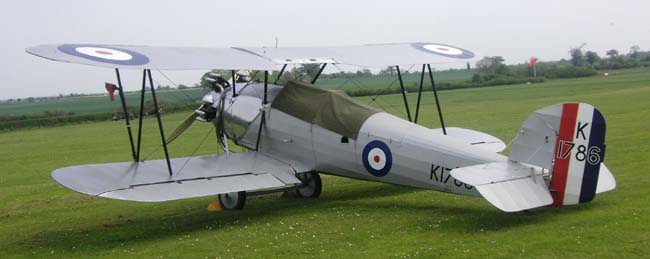 |
The Hawker Tomtit was an earlier attempt to
introduce a more modern trainer to the Royal Air Force. It first
flew in November 1928. It is lower powered than the Avro Tutor,
having a 150hp five cylinder Armstrong Siddeley Mongoose radial
engine. It was actually faster than the Tutor, with a top speed of
125mph, though obviously considerably lighter: gross weight was
1,750lb. Only 36 were built, the Tutor eventually being preferred.
This one is kept airworthy at Old Warden, where
it was photographed by Ivy in Summer 2005. |
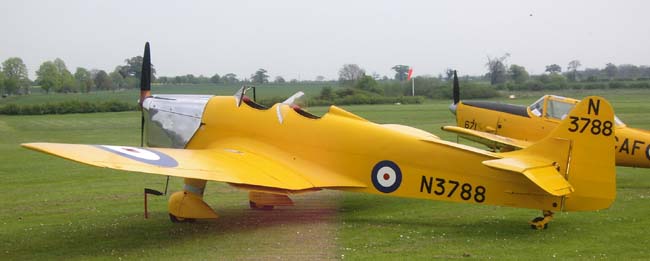 |
The Miles M.14 Magister was a sleek, racy-looking
trainer designed to complement the Tiger Moth (see under private
aircraft) in flying training schools in the Second World War.
Powered by a 130hp De Havilland Gipsy Major engine, it could manage
140mph over a range of 370 miles. Gross weight was 1,900lb. Wing
span was 33 feet, 10 inches; length, 24 feet 7 inches.
The Magister was an evolutionary development
of the earlier M.2X Hawk Trainer, which first flew in 1935. In its
Magister form, it flew in 1937. Almost 1,400 were built, mostly for
the RAF. A noteworthy feature was the very effective split flaps,
which reduced landing speed and obviated the need for sideslips on
approach.
This one is preserved in immaculate flying
condition and was seen at Old Warden in July 2005. |
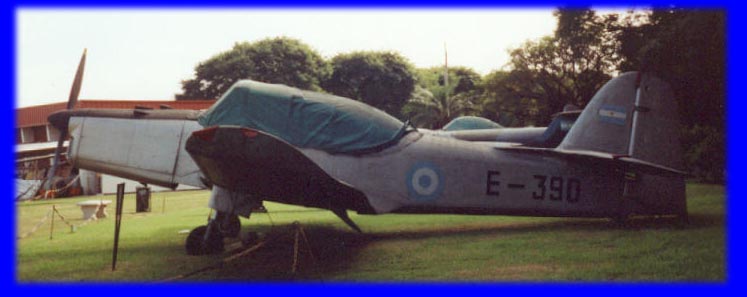
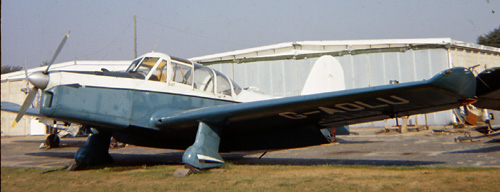 |
The Percival Prentice was a three seat basic
trainer which first flew in March 1946. 417 were built, mostly for
the RAF but also for export to Argentina, India and Lebanon. It was
(under) powered by a single 250hp Gipsy Queen engine. It was a very
heavy aircraft, empty weight being 3,230lb and gross weight 4,350lb.
It was also quite large, with a span of 46 feet and length of 31
feet 6 inches. Its service life was very short, being replaced from
1955 onwards by the far more capable Provost. Top speed was 140mph
and range 400 miles - not dissimilar from the far smaller Magister.
A few were converted for civil use after retirement, including one
amazingly as a seven seater! But they were not competitive against
the new designs emerging from America. A few survive as curiosities,
and some (such as the top one, pictured at Buenos Aires in 1999) in
museums. The lower picture was taken at Coventry in August 1975. |
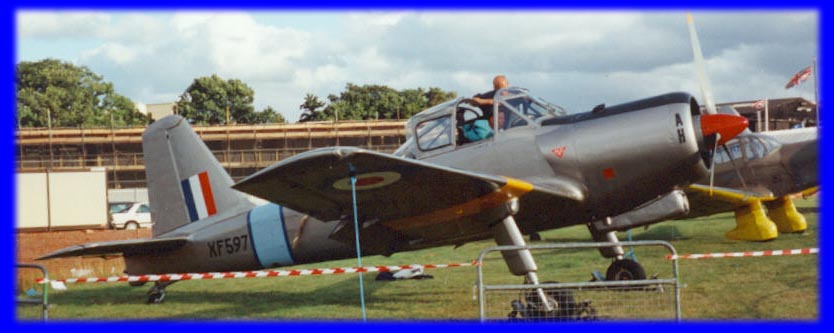 |
The Percival Provost was an even heavier
aircraft than the Prentice, grossing 4,400lb and with an empty
weight of 3,750lb. But, being powered by a 550hp Alvis Leonides
radial engine, it was a far more capable performer. It could reach
200mph, with a range of 648 miles, and superb aerobatic handling. It
first flew in February 1950. 412 were built.
They too had a relatively short service life, in
this case because they were replaced by Jet Provosts from the late
1950s. This one, kept in flying condition, was at Farnborough in
September 1998. |
|
|
The Vickers Varsity was the last in the line
of Vickers twin-radial aircraft which could trace their ultimate
pedigree to the Wellington bomber of the Second World War. Equipped
with a rapidly contrived new fuselage, the tailwheel Viking had been
the mainstay of the British light transport fleet from the mid 1940s
through the 1950s. The military equivalent was the Valetta. Needing
a more capable aircraft as a navigation and multi-engine trainer,
the RAF ordered a nosewheel-equipped version, which became the
Varsity. It first flew in July 1949.
Engines are two 1950hp Bristol Hercules two row, fourteen cylinder
radials. This gave it a top speed of over 280mph over a range of
2,650 miles. Empty weight was 27,000lb and gross weight 37,500. It
normally carried up to nine people: pilot, navigator, bomb aimer and
signaller, each paired with a student: there were normally two
navigator students at a time. 163 were built.
It was still in service into the 1980s. The
top picture is of WL679 at Fairford in July 1985. The lower picture
is of WJ645 on a very wet day at Finningley, September 1980. |
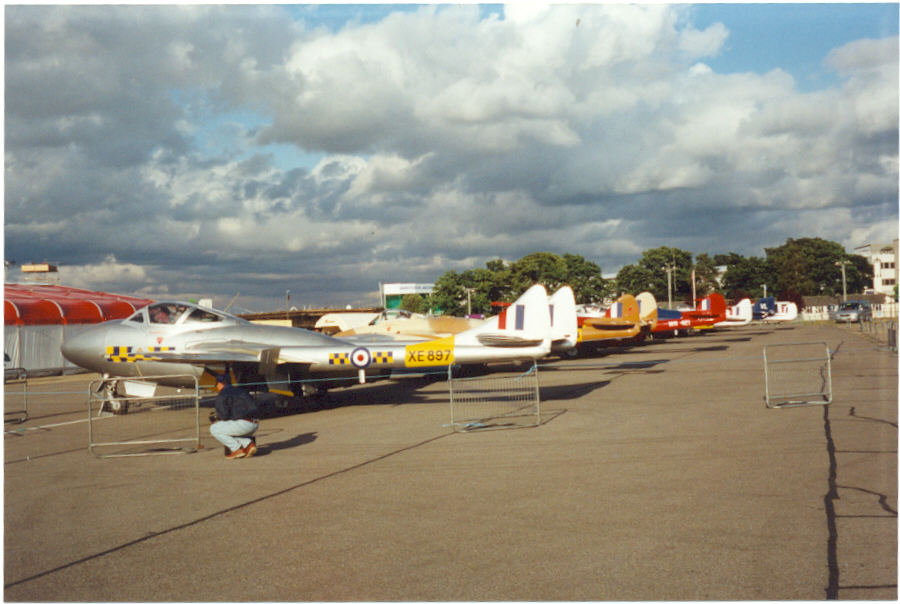 |
The De Havilland Vampire was one of Britain's
first jet fighters, first flying in September 1943 and only just
missing action in the Second World War. It was not long before the
need for an advanced jet trainer became clear, so a two seat version
of the Vampire, the DH115 Vampire T.11, was developed. It first flew
in November 1950. Apart from the twin seats, it is readily
distinguished by the shape of the tail, quite distinct from the
other marks of Vampire and Venom. It was powered by a DH Goblin
turbojet of 3,500lb thrust. Top speed was 538mph and range was 1,170
miles. Gross weight was 11,150lb and useful load (mostly fuel!)
3,900lb. About 1,000 of the trainer version were built, on top of
the 2,579 built as fighters and 250 built under license in France as
the Sud-Est Mistral. This one, part of a
line-up of DH types, was at Farnborough in September 1998. |
|
|
The Folland Gnat was designed by W.E. Petter
(of English Electric fame) as a very simple, lightweight jet
fighter; and in service with the Indian air force it achieved
considerable success in that role. It first flew in July 1955. With
the RAF, however, it found its true purpose in two seat form as an
advanced jet trainer. It was powered by a single Bristol Siddeley
Orpheus turbojet of 4,230lb thrust, giving it a top speed of 640mph
and endurance of two and a quarter hours. Gross weight was only
7,500lb. 46 of the fighter version were built in the UK, and 195 in
India. 79 more were built in India as the Ajeet. Of the trainer
version, 105 were built, all in the UK.
The Gnat is particularly famous as the first mount of the RAF
aerobatic team the Red Arrows. The top picture shows the Red Arrows
in `Concorde' formation at Finningley in 1975. The lower picture
shows a demobilised Gnat in striking colours at Fairford in July
2007. |
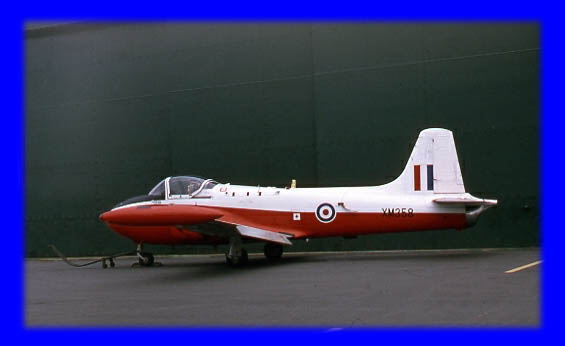 |
The Hunting Jet Provost was first made by
Hunting after they took over the Percival company in the early
1950s. They took a standard Percival Provost, replaced the radial
engine with a 2,500lb Bristol Siddeley Viper turbojet, and gave it a
nosewheel undercarriage. From that simple beginning, several models
were developed, providing the RAF with a standard and safe basic jet
trainer which lasted many years, from its first flight in June 1954
to retirement in the late 1980s. Top speed was 410mph and range 900
miles. Gross weight was 9,200lb. 587 were built, of all marks.
This T.3A was pictured at Leeming in March
1979. |
 |
The De Havilland Dominie T1 is a specialised
navigation trainer derived from the DH125 executive jet and powered
by the same Rolls-Royce Viper turbojets. It carries two crew and
four students. It was originally equipped with Doppler radar (in the
bulge under the fuselage in front of the wing), but most have now
been upgraded with Thorn Super Searcher radar. It first flew in
December 1964. 20 were built.
These two, in the colours of 6FTS, were at Finningley
in September 1975. |
|
|
Scottish Aviation took over the design rights
to the Beagle Pup after the tragic demise of Beagle at the hands of
the horrific Department for Trade and Industry in the late 1960s.
Beagle had been developing a military trainer version, which Scottish
Aviation completed to create the Bulldog. An elementary trainer,
intended to replace the Canadian Chipmunk, it differed from the Pup
primarily in its sliding canopy, 200hp Lycoming engine, and military
standard cockpit layout. It first flew in May 1969. Top speed is
150mph and range is 620 miles. Gross weight is 2,350lb. 320 were
built, including large numbers for export.
Top: Bulldog T1 at Leeming in March 1979. Bottom:
Imaginatively painted Bulldog at Fairford, July 2007. |
|
|
The British Aerospace Hawk is probably the
most successful of the post-war British trainers, with almost 560
built to date plus 174 for the US Navy as the T-45 Goshawk. Powered
by a single 5,200lb thrust Rolls-Royce / Turbomeca Adour turbojet,
it can reach 650mph and has a useful range of 1,500 miles. It first
flew in August 1974. Following
retirement of the Gnat, the Hawk became the mount of the RAF's
aerobatic team, the `Red Arrows', which gives a good excuse for the
group of photographs here. The top picture shows two Red Arrows
Hawks at the point of crossover in their display. Below is a Hawk
from 208 Squadron at Brawdy in a special colour scheme at Fairford
in July 2005. The other pictures are also from Fairford, the
centrepiece showing the Red Arrows flying in formation with three
Spitfires from the Second World War. |





|